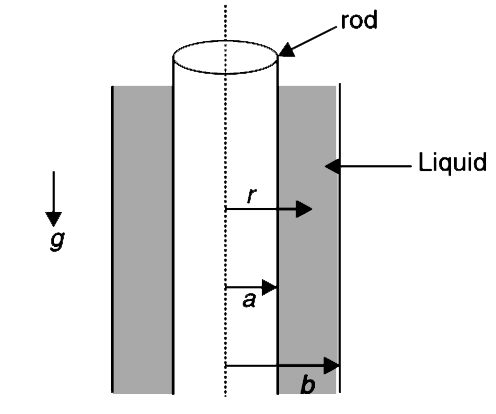Define coefficient of viscosity and give its SI unit. On what factors does the terminal velocity of a spherical ball falling through a viscous liquid depend ? Derive the formula where the symbols have their usual meanings.
Step by step video & image solution for Define coefficient of viscosity and give its SI unit. On what factors does the terminal velocity of a spherical ball falling through a viscous liquid depend ? Derive the formula upsilon_t = (2 r^2 g)/(9 eta) (rho - rho^1) where the symbols have their usual meanings. by Physics experts to help you in doubts & scoring excellent marks in Class 11 exams.
Updated on:21/07/2023Topper's Solved these Questions
- Mechanical Properties of fluidsBOOK - SL ARORACHAPTER - Mechanical Properties of fluidsEXERCISE - Exercise
459 Videos
- Mathematical toolsBOOK - SL ARORACHAPTER - Mathematical toolsEXERCISE - Exercise
20 Videos
- Mechanical Properties of SolidsBOOK - SL ARORACHAPTER - Mechanical Properties of SolidsEXERCISE - Example
113 Videos
Similar Questions
Define terminal velocity. Show that the terminal velocity υ of a sphere of radius r, density ρ falling vertically through a viscous fluid of density σ and coefficient of viscosity η is given by υ=29(ρ−σ)r2gη Use this formula to explain the observed rise of air bubbles in a liquid.
View SolutionWhat do you understand by resistance of a conductor ? Define its SI unit. Show that resistance of a conductor is given by R=mlne2τA, where the symbols have their usual meanings.
View Solution
Knowledge Check
Assertion : Units of Rydberge constant R are m−1.
Reason : It follows from Bohr's formula [¯¯¯V=R(1n21−1n22)], where the symbole have their usual meaning.AIf both Assertion and Reason are true and the Reason is the correct explanation of the Assertion.BIf both , Assertion and Reason are true but Reason is not a correct explanation of the Assertion.CIf Assertion is true but the Reason is false.DIf both, Assertion and Reason are false.A small steel ball of radius r is allowed to fall under gravity through a column of a viscous liquid of coefficient of viscosity η. After some time the velocity of the ball attains a constant value known as terminal velocity υT. The terminal velocity depends on (i) the mass of the ball m (ii) η, (iii) r and (iv) acceleration due to gravity g . Which of the following relations is dimensionally correct?
AvT∝mgηrBvT∝ηrmgCvTηrmgDvT∝mgrη
Find the dimensional formulae of the following quantities:
a. the universal constant of gravitation G,
b. the surface tension S,
c. the thermal conductivity k and
d. the coeficient of viscosity η.
Some equation involving these quantities are
F=Gm1m2r2,S=ρgrh2,
Q=kA(θ2−θ1)tdandF=−ρAv2−v1x2−x1
where the symbols have their usual meanings.
View SolutionAc cording to Bernoulli's theorem for the streamline flow of an ideal liquid, the sum of pressure energy/mass, kinetic energy/mass and potential energy /mass remains constant at every cross section, throughout the liquid flow. i.e., Pρ+12υ2+gh = cosntant, where the symbols have their usual meaning. Note that an ideal liquied is the one, which is perfectly incompressible, irrotational and non visous. Read the above passage and answer the following question ? (i) At what speed will the velocity head of a stream of water be equal to 40 cm ? (ii) What is the implication of Bernoulli's theorem in day to day life ?
View SolutionA vertical steel rod has radius a. The rod has a coat of a liquid film on it. The liquid slides under gravity. It was found that the speed of liquid layer at radius r is given by
v=ρgb22ηln(ra)−ρg4η(r2−a2)
Where b is the outer radius of liquid film, η is coefficient of viscosity and ρ is density of the liquid.
(i) Calculate the force on unit length of the rod due to the viscous liquid?
(ii) Set up the integral to calculate the volume flow rate of the liquid down the rod. [you may not evaluate the integral]

View SolutionA sonometer wire of density ρ and radius r is held between two bridges at a distance L apart . Tension in the wire is T. then the fundamental frequency of the wire will be
View SolutionA solid sphere, of radius R acquires a terminal velocity v1 when falling (due to gravity) through a viscous fluid having a coefficient of viscosity h. The sphere is broken into 27 identical solid spheres. If each of these spheres acquires a terminal velocity, v2, when falling through the same fluid, the ratio (v1/v2) equal 9x. Find the value of x.
View SolutionFind the dimensional formulae of following quantities:
(a) The surface tension S,
(b) The thermal conductivity k and
(c) The coefficient of viscosity η.
Some equation involving these quantities are S=ρgrh2 Q=kA(θ2−θ1)tdand F=−ηAv2−v1x2−x1,
where the symbols have their usual meanings. (ρ-density, g- acceleration due to gravity , r-radius,h-height, A-area, θ1&θ2- temperatures, t-time, d-thickness, v1&v2 -velocities, x1&x2 - positions.)
View Solution
